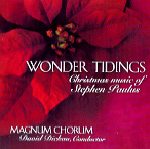American composer Stephen Paulus writes intelligent music that challenges singers and requires more keen attention from listeners than does the vast majority of today’s new choral repertoire. This disc opens with four works–a set of Three Nativity Carols and a separate piece called Hallelu!–that, although original in rhythmic and melodic treatment of some familiar texts, fall easily within more traditional melodic/harmonic structures than the works that follow. The Three Nativity Carols–The Holly and the Ivy, This Endris Night, and Wonder Tidings, accompanied by harp and oboe–are well-formed and very easy on the ear, while Hallelu! (also with harp) features a lovely chant-like melody initially sung by women’s voices, nicely supported by a cooly undulating harp (which also provides a nifty harmonic twist at the end). Eventually the men add another layer to the dreamy atmosphere, and at the end we’re left with a satisfied smile–and wishing for just a little more.
The latter two-thirds of the program includes a set of four works under the heading Jesu Carols and another group of eight pieces collected under the name Canticum Novum. Since no information is given in the liner notes concerning the music itself, the rationale for these sets of works is not clear. Regardless, the scoring in the Jesu Carols (harp) and the text selection (mostly from ancient English poetic sources) is more than a little reminiscent of Benjamin Britten in his A Ceremony of Carols. Britten also comes to mind in the Canticum Novum pieces where Paulus uses texts from Christopher Smart and John Milton in addition to a medieval prayer, carol, and processional.
The music itself is pure Paulus, built on bold, often dissonant, unresolved harmonic foundations through which melodic lines move and reform above and within new yet equally ambiguous harmonies, creating very fluid–sometimes disorienting–structures. Yet there’s also a consistently ebullient, buoyant, sanguine quality, even in the thornier pieces, which is ideal for the spirit and letter of the texts. Throughout, you notice that color and texture are significant features of these works, and substantial technical skill is required to maintain intonation and sustain the high level of energy required for successful performance. And happily, those things are not a problem for these excellent singers, who are “alumni of the St. Olaf College choirs in Northfield, Minnesota”, or for their conductor, David Dickau, who obviously inspired his choir to make some very wonderful sound here.
Speaking of sound, the recording works slightly against the voices in that the overly resonant space inhibits our ability to hear the clarity and detail we would experience in a drier (or differently staged) environment. This is not all easy listening, but it’s definitely a rewarding 50-plus minutes, enlightening and informing us of important work by one of today’s more imaginative and thoughtful composers. (One note for future productions: Please include track numbers in the liner notes next to the listing of work titles and texts!) [9/30/2003]
































